Special Feature: Products Sally Recommends
all about hot chocolate
I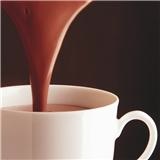 t wasn’t always like this, at least in the US. When I was a kid, the only heated chocolate beverage around was some form of hot cocoa. And it was great; in fact, it still is. But one night about fifteen years ago now, I went to bed as usual. When I woke up the next morning, the country was almost awash in hot chocolates. Do you know the differences between the two, and are you aware of the great number of these products now available?
t wasn’t always like this, at least in the US. When I was a kid, the only heated chocolate beverage around was some form of hot cocoa. And it was great; in fact, it still is. But one night about fifteen years ago now, I went to bed as usual. When I woke up the next morning, the country was almost awash in hot chocolates. Do you know the differences between the two, and are you aware of the great number of these products now available?
A definition would be a fine place to start. It’s important to note that there are no legal standards for hot cocoa or hot chocolate (also called drinking chocolate and sipping chocolate). Technically, however, a hot cocoa contains cocoa powder (that seems self-evident, but bear with me). Traditionally, hot cocoa is a thin beverage, made with milk; it’s less rich, and often sweeter, than a hot chocolate. A hot chocolate is, in theory, made with actual chocolate. Historically, hot chocolate tends to be richer than hot cocoa. It can also be thicker. Hot chocolates vary in sweetness; many are semisweet or even bittersweet. And they can be made with either milk or water. But these definitions are merely traditional, and manufacturers will sometimes swap names when they think it to their advantage.
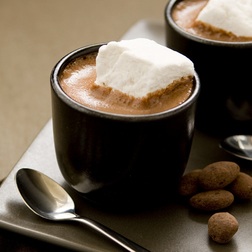 What else is in hot chocolate or hot cocoa, aside from actual chocolate or cocoa powder? That depends on who’s making it. In its most elemental form, a hot chocolate mix may contain only shaved chocolate or chocolate bits. If the chocolate is of high quality, you don’t necessarily require anything else. Add the appropriate quantity of water or milk and heat the mixture over low heat until steaming hot, stirring often---it doesn’t get much more enjoyable than that. A good hot cocoa mix will likely contain a sweetener (such as evaporated cane juice or sugar) in addition to cocoa powder; it may also have some form of powdered milk, a flavoring (such as vanilla powder), and perhaps a tiny amount of salt to bring out more of a chocolate presence. I happen to like Dutch process cocoa powder (also known as alkalized cocoa powder), but that’s a matter of personal taste.
What else is in hot chocolate or hot cocoa, aside from actual chocolate or cocoa powder? That depends on who’s making it. In its most elemental form, a hot chocolate mix may contain only shaved chocolate or chocolate bits. If the chocolate is of high quality, you don’t necessarily require anything else. Add the appropriate quantity of water or milk and heat the mixture over low heat until steaming hot, stirring often---it doesn’t get much more enjoyable than that. A good hot cocoa mix will likely contain a sweetener (such as evaporated cane juice or sugar) in addition to cocoa powder; it may also have some form of powdered milk, a flavoring (such as vanilla powder), and perhaps a tiny amount of salt to bring out more of a chocolate presence. I happen to like Dutch process cocoa powder (also known as alkalized cocoa powder), but that’s a matter of personal taste.
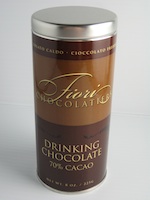 As I’m sure you know by now, good chocolate and good quality cocoa powder are expensive. Manufacturers are also well aware of this, and some will make their hot cocoa or hot chocolate mixes out of inferior ingredients. This keeps down the cost of the end product, which they can then sell cheaply while making a handsome profit. Manufacturers also make their products according to their perceptions of what the public will like. For instance, thicker hot beverages are regarded as richer and more satisfying. To thicken a hot chocolate, you usually increase the proportion of chocolate in the mix. Some producers do exactly that, but others might add thickeners such as sodium caseinate, guar gum, cellulose gum, xanthan gum, or carrageenan. Historically, hot cocoa just isn’t that thick a drink, but countless companies add one or more of the above ingredients so it’s perceived as richer, particularly if the mix is fat-free (some thickeners can add a fat-like feeling in your mouth). Additives like monoglycerides, diglycerides, and Polysorbate 60 are added to mixes as emulsifiers, meaning that that they blend certain substances (such as water and oil) that would otherwise not combine well. Yes, vegetable oils are sometimes employed to increase fat content, so the end product seems more luxurious. In fact, I’ve seen mixes that contain partially hydrogenated oils, which means that the mixes will supply trans fats, substances it’s best to avoid. Because some mixes are formulated for long shelf-life, you’ll find anti-caking agents in them, notably tricalcium phosphate and silicon dioxide. A cheap sweetener such as corn syrup solids may be used in place of some (or all) of the sugar in a mix.
As I’m sure you know by now, good chocolate and good quality cocoa powder are expensive. Manufacturers are also well aware of this, and some will make their hot cocoa or hot chocolate mixes out of inferior ingredients. This keeps down the cost of the end product, which they can then sell cheaply while making a handsome profit. Manufacturers also make their products according to their perceptions of what the public will like. For instance, thicker hot beverages are regarded as richer and more satisfying. To thicken a hot chocolate, you usually increase the proportion of chocolate in the mix. Some producers do exactly that, but others might add thickeners such as sodium caseinate, guar gum, cellulose gum, xanthan gum, or carrageenan. Historically, hot cocoa just isn’t that thick a drink, but countless companies add one or more of the above ingredients so it’s perceived as richer, particularly if the mix is fat-free (some thickeners can add a fat-like feeling in your mouth). Additives like monoglycerides, diglycerides, and Polysorbate 60 are added to mixes as emulsifiers, meaning that that they blend certain substances (such as water and oil) that would otherwise not combine well. Yes, vegetable oils are sometimes employed to increase fat content, so the end product seems more luxurious. In fact, I’ve seen mixes that contain partially hydrogenated oils, which means that the mixes will supply trans fats, substances it’s best to avoid. Because some mixes are formulated for long shelf-life, you’ll find anti-caking agents in them, notably tricalcium phosphate and silicon dioxide. A cheap sweetener such as corn syrup solids may be used in place of some (or all) of the sugar in a mix.
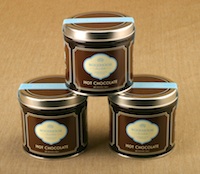 While most of the above ingredients are not harmful in and of themselves, their place in a good hot cocoa or hot chocolate mix is debatable, to say the least. I hope you will choose to patronize manufacturers using fewer of these ingredients, rather than those using more of them. Admit it: strictly speaking, we don’t need to consume hot cocoa or hot chocolate. But if you’re going to indulge in either (or both), aren’t you worth the good stuff, the real deal? Of course you are! So keep reading labels, and choose your hot chocolate and hot cocoa wisely.
While most of the above ingredients are not harmful in and of themselves, their place in a good hot cocoa or hot chocolate mix is debatable, to say the least. I hope you will choose to patronize manufacturers using fewer of these ingredients, rather than those using more of them. Admit it: strictly speaking, we don’t need to consume hot cocoa or hot chocolate. But if you’re going to indulge in either (or both), aren’t you worth the good stuff, the real deal? Of course you are! So keep reading labels, and choose your hot chocolate and hot cocoa wisely.
Recommendations for Hot Chocolate and Hot Cocoa Mixes
The following businesses make some excellent hot chocolate and cocoa mixes. As usual, this is an incomplete list. And note that I have not tried any of the flavored varieties (spicy, nutmeg, peppermint, etc.).
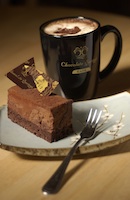 Chocolate Springs, www.chocolatesprings.com. Serious Hot Chocolate
Chocolate Springs, www.chocolatesprings.com. Serious Hot Chocolate
Enric Rovira, www.alegio.com, Chocolate a la Taza. The varieties are Tradicional (Traditional), Sin Azucar (Sugar-Free), and Amargo (Bittersweet)
Fiori Chocolatiers, www.fiorichocolatiers.com. Available in 70% and Peperoncino (Spicy)
Recchiuti Confections, www.recchiuti.com, Dark Hot Chocolate (under “Nuts, Fruits, & Snacks”)
Woodhouse Chocolate, www.woodhousechocolate.com. Original Dark, Nutmeg, Peppermint, and Madagascar (the latter made from both Madagascar vanilla and Madagascar chocolate)
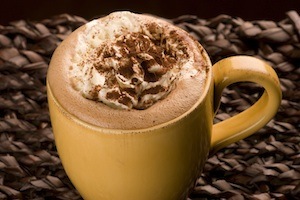 Dorado Artisan Chocolatier, www.doradochocolates.com. The ingenious Hot Cocoa Kit consists of chocolate-covered marshmallows that you drop into hot milk. I know it isn’t a mix, but if you like to play with your food as much as I do, you won’t care about that technicality either.
Dorado Artisan Chocolatier, www.doradochocolates.com. The ingenious Hot Cocoa Kit consists of chocolate-covered marshmallows that you drop into hot milk. I know it isn’t a mix, but if you like to play with your food as much as I do, you won’t care about that technicality either.
Christopher Norman Chocolates, www.christophernormanchocolates.com. The Hot Chocolate isn’t always listed on their website, but it is very much available at this writing, and you can call to order it.
Recipe of the Month
Sipping Chocolate
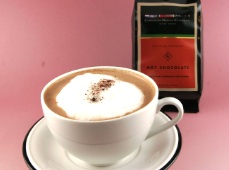 Hot chocolate or doubly rich hot cocoa? You’ll have to decide that one for yourself. This is quickly made, and just as quickly gone. Variations on this theme are practically infinite: you can add more or less sugar, add a teaspoon or two of instant coffee granules or espresso powder before processing the chocolate mixture, substitute a chocolate-compatible liqueur for the vanilla, top the finished drink with lightly sweetened whipped cream, etc.
Hot chocolate or doubly rich hot cocoa? You’ll have to decide that one for yourself. This is quickly made, and just as quickly gone. Variations on this theme are practically infinite: you can add more or less sugar, add a teaspoon or two of instant coffee granules or espresso powder before processing the chocolate mixture, substitute a chocolate-compatible liqueur for the vanilla, top the finished drink with lightly sweetened whipped cream, etc.
I’ve made this with 2% milk, but I really think that whole milk works better. Any leftovers can be refrigerated for a day or so. Reheat in microwave at medium (50%) power just until very hot, whisking frequently.
2 ounces best-quality semisweet or bittersweet chocolate, chopped
2 Tablespoons unsweetened cocoa powder, preferably Dutch process (alkalized)
2 Tablespoons granulated sugar
Few grains of salt
1-1/2 cups milk
2 teaspoons vanilla extract
In small work bowl of food processor fitted with steel blade, combine chopped chocolate, cocoa powder, sugar, and salt. Process at high speed just until finely ground. (Because this is a small quantity, you can use a clean spice grinder, or one that has been used to grind chocolate-compatible spices, to process the mixture.) Empty mixture into heatproof bowl or pitcher of at least 3 cup capacity.
Heat milk in microwavable container (I use a liquid measuring cup) of about 2 cup capacity until steaming hot. Add about 1/4 cup of hot milk to chocolate mixture, whisking briskly until very smooth. Gradually whisk in remaining hot milk until well-combined.
If necessary, reheat in microwave, using medium (50%) power until steaming hot. Whisk in vanilla. Pour into serving cups; serve immediately.
About 1-3/4 cups; 2 to 3 servings
Photo credit: Kevin Sprague for Chocolate Springs.
![]()
Stephanie (HandOverTheChocolate@comcast.net) has had a strong affinity for chocolate from a very early age. Family members claim that, as a child, she was able to hear chocolate being opened in the kitchen no matter where she was in the house. Stephanie was baking by the time she was 6 and ran a short-lived baking business out of her parents’ kitchen when she was in high school. She has a Master’s Degree in Foods from Virginia Tech but no formal training in cooking or baking. Consequently, she is a home cook, not a chef. Prior to beginning this column, she had written about chocolate for some 8 years.
Note: This information was accurate when it was published. Please be sure to confirm all rates and details directly with the businesses in question before making your plans.



